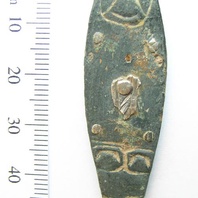
Viking Objects
Zoomorphic Strap-End (SWYOR-B89D43)
This Thomas Type A strap-end is decorated with zoomorphic designs and what seems to be a face which may fall into the Trewhiddle style. There is some trace evidence of silver plating. Strap-ends came in various styles and were fairly common throughout the Viking world. They were used to decorate the ends of belts and to stop them getting damaged.
Read More
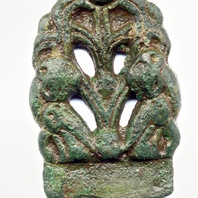
Viking Objects
Anglo-Scandinavian Strap-End (LEIC-0C2B81)
This example of an Anglo-Scandinavian copper-alloy strap-end displays foliate decoration and features a mixture of the Anglo-Saxon Winchester style and Anglo-Scandinavian zoomorphic heads. It is classified as Thomas Class E, Type 1.
Read More
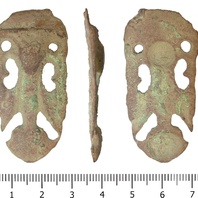
Viking Objects
Tongue-Shaped Strap-End (DENO-1268B3)
An incomplete, copper-alloy strap-end with anthropomorphic designs. These types of strap-ends were popular in both Scandinavia and on the Carolingian continent between the 9th and 10th centuries and were regularly used to embellish baldrics. Strap-ends came in various styles and were fairly common throughout the Viking world. They were used to decorate the ends of belts and to stop them getting damaged.
Read More
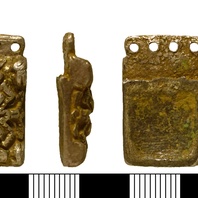
Viking Objects
Carolingian Style Strap-End (NARC-10F5B2)
This silver strap-end is decorated with foliate design cast in relief and is categorized as Thomas (2003) Class E, Type 5 (Carolingian). Carolingian belt fittings from England could have been imported either indirectly through Scandinavia or directly from the Continent. It is possible that this strap end was brought over by Scandinavians after their raids on the continent.
Read More
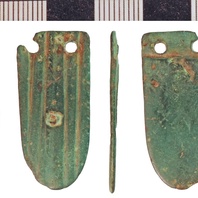
Viking Objects
Copper-Alloy Strap-End (NLM-B633CE)
The decoration on this cast copper-alloy strap-end involves a series of deep longitudinal grooves which may actually represent previous damage. If decorative, the object is similar to Thomas Class E Type 3 strap ends whose distribution generally falls in the eastern Danelaw and around the Irish Sea. Strap ends came in various styles and were fairly common throughout the Viking world. They were used to decorate the ends of belts and to stop them getting damaged.
Read More
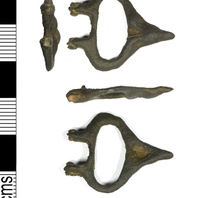
Viking Objects
Copper Alloy Buckle (LEIC-917DEC)
This buckle consists of an oval loop with a circular cross section and has an elongated triangular pin rest in the form of an animal head. The animal head has a pointed snout, rounded head with rounded upwards pointing ears which merge into the buckle loop. At the opposite side there are two short sub-rectangular cross-sectioned shafts which would have housed an iron pin that held the buckle pin and possibly an articulated plate.
Read More
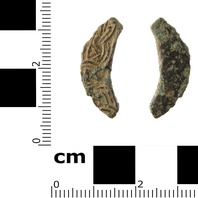
Viking Objects
Copper-Alloy Buckle Fragment (SWYOR-1F57BC)
This copper-alloy fragment is probably part of a flat buckle-frame decorated with Borre-style interlace though very few comparable examples exist.
Read More
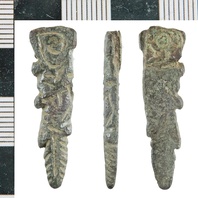
Viking Objects
Strap-End (NLM-42CC0B)
This copper-alloy strap-end is classified as a Thomas Class G type with Viking attributes. The decoration consists of large bordered eye-shaped interlace which may possibly resemble the Urnes style. Strap ends came in various styles and were fairly common throughout the Viking world. They were used to decorate the ends of belts and to stop them getting damaged.
Read More
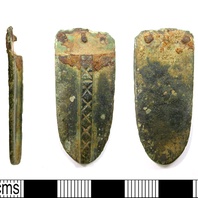
Viking Objects
Copper-Alloy Strap-End (LEIC-07ED69)
This tongue-shaped strap-end, classed as Thomas Class E Type 3, is decorated with a rectangular cross-sectioned vertical ridge running down its centre with incised ‘saltaire’ crosses.
Read More
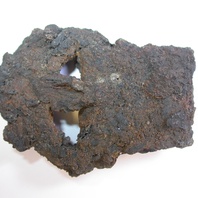
Viking Objects
Iron Buckle (1985/225-8)
An iron buckle found in Mound 6 at Heath Wood, Ingleby, Derbyshire. It is one of two iron buckles found in this burial mound together with a small number of bronze fragments and iron nails. This buckle has parallels in Scandinavia.
Read More
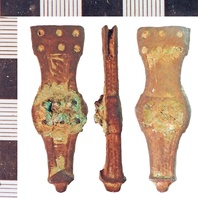
Viking Objects
Irish Strap-End (NLM-A30415)
This Irish-type strap-end has been classified as a Thomas Class F strap-end. One of the panels seems to have retained a possible reticulated interlace pattern while the inner area is decorated with six dots of inlay. Its manufacture is possibly traced to Dublin between c. 950-1050 and it is likely linked to Viking distribution of Irish artefacts. Strap-ends came in various styles and were fairly common throughout the Viking world. They were used to decorate the ends of belts and to stop them getting damaged.
